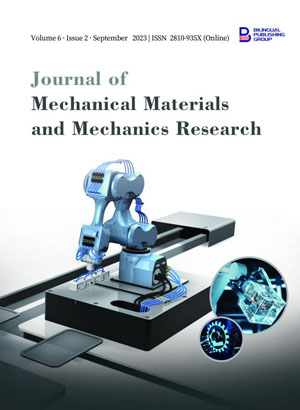-
211
-
124
-
83
-
80
-
73
Offline Trajectory Generation for Bipedal Robot Using Linear Inverted Pendulum Model
DOI:
https://doi.org/10.30564/jmmmr.v6i2.5852Abstract
Reduced order model (ROM)-based controllers have proved to be effective to generate stable bipedal locomotion. However, it is important to understand the limitations and effectiveness of these models without implementing any controllers. This study highlights the versatility of the Linear Inverted Pendulum Model (LIPM) at various walking speeds. Firstly, the Centre of Mass (COM) trajectory has been generated using the LIPM model, and the foot motion trajectory has been created using a sixth-order polynomial function. The trajectory is generated using a predefined step length, speed of locomotion and COM height. Secondly, the task space trajectory has been converted into a joint space trajectory through inverse kinematics for a 6-degree-of-freedom leg. To facilitate the proper walking motion the contact between the foot sole and the ground is implemented. Finally, a simple bipedal robot in MATLAB/Simulink has been modelled and the generated trajectories were implemented.
Keywords:
Bipeds; Gait; Inverse kinematics; Joint space; Reduced order model (LIPM); Task space; TrajectoryReferences
[1] Pieper, D.L., 1969. The kinematics of manipulators under computer control. Stanford University: Stanford.
[2] Kajita, S., Morisawa, M., Miura, K., et al. (editors), 2010. Biped walking stabilization based on linear inverted pendulum tracking. 2010 IEEE/RSJ International Conference on Intelligent Robots and Systems; 2010 Oct 18-22; Taipei, Taiwan. New York: IEEE. p. 4489-4496.
[3] Vukobratović, M., Borovac, B., 2004. Zero-moment point—thirty five years of its life. International Journal of Humanoid Robotics. 1(1), 157-173.
[4] Choi, Y., Kim, D., Oh, Y., et al., 2007. Posture/walking control for humanoid robot based on kinematic resolution of com jacobian with embedded motion. IEEE Transactions on Robotics. 23(6), 1285-1293.
[5] Kajita, S., Kanehiro, F., Kaneko, K., et al. (editors), 2001. The 3D linear inverted pendulum mode: A simple modeling for a biped walking pattern generation. Proceedings 2001 IEEE/RSJ International Conference on Intelligent Robots and Systems. Expanding the Societal Role of Robotics in the the Next Millennium (Cat. No.01CH37180); 2001 Oct 29-Nov 3; Maui, HI, USA. New York: IEEE.
[6] Ohka, M., Yussof, H., 2010. Optimum biped trajectory planning for humanoid robot navigation in unseen environment. Robot Localization and Map Building. InTech: England. pp. 176-206.
[7] Wang, H., Tian, Y., Han, S., et al., 2017. ZMP theory-based gait planning and model-free trajectory tracking control of lower limb carrying exoskeleton system. Studies in Informatics and Control. 26(2), 161-170.
[8] Liu, Y., Zang, X., Heng, S., et al., 2017. Human-like walking with heel off and toe support for biped robot. Applied Sciences. 7(5), 499.
[9] Xhevahir, B., Ahmet, S., Gezim, H., et al., 2018. Dynamic modelling and analyzing of a walking of humanoid robot. Strojnícky časopis-Journal of Mechanical Engineering. 68(3), 59-76.
[10] Nenchev, D.N., Konno, A., Tsujita, T., 2018. Humanoid robots: Modeling and control. Butterworth-Heinemann: Oxford.
[11] Jazar, R.N., 2010. Theory of applied robotics. Springer Science + Business Media, LLC.: Berlin.
[12] Manipulator Dynamics [Internet]. Available from: https://ocw.snu.ac.kr/sites/default/files/NOTE/Chap06_Manipulator%20dynamics.pdf
[13] Ali, M.A., Park, H.A., Lee, C.G. (editors), 2010. Closed-form inverse kinematic joint solution for humanoid robots. 2010 IEEE/RSJ International Conference on Intelligent Robots and Systems; 2010 Oct 18-22; Taipei, Taiwan. New York: IEEE. p. 704-709.
Downloads
How to Cite
Issue
Article Type
License
Copyright © 2023 Navneet Ratre, S.K. Panigrahi, Shivam Dubey

This is an open access article under the Creative Commons Attribution-NonCommercial 4.0 International (CC BY-NC 4.0) License.




 Navneet Ratre
Navneet Ratre





